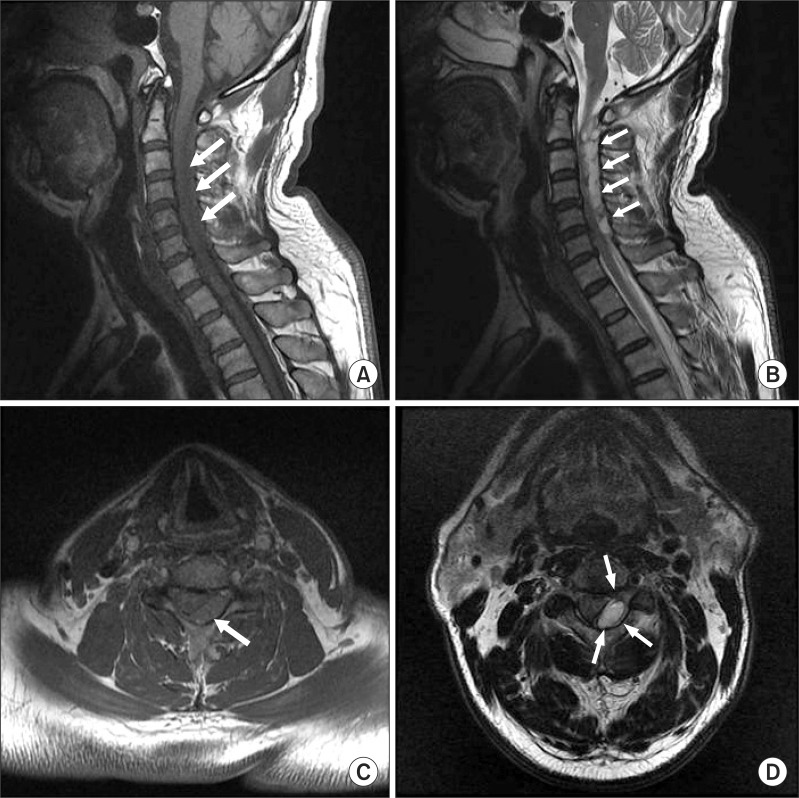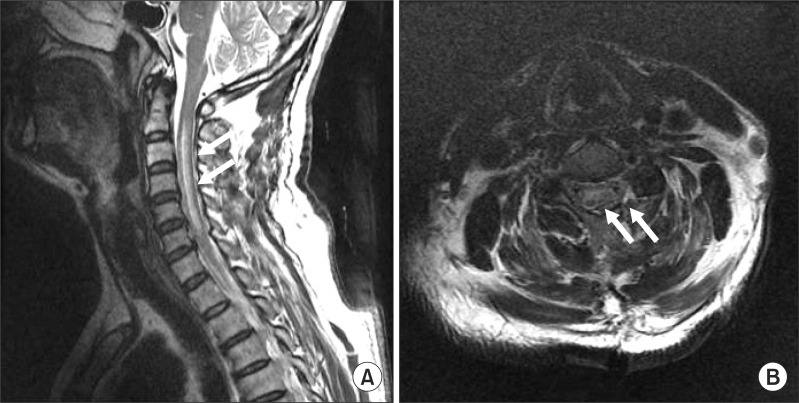Ann Rehabil Med.
2013 Feb;37(1):123-126. 10.5535/arm.2013.37.1.123.
Spontaneous Cervical Epidural Hematoma Presenting as Brown-Sequard Syndrome Following Repetitive Korean Traditional Deep Bows
- Affiliations
-
- 1Department of Physical and Rehabilitation Medicine, Research Institute of Medical Sciences, Center for Aging and Geriatrics, Regional Cardiocerebrovascular Center, Chonnam National University Hospital, Chonnam National University Medical School, Gwangju,
- KMID: 2266660
- DOI: http://doi.org/10.5535/arm.2013.37.1.123
Abstract
- Spontaneous cervical epidural hematoma (SCEH) is an uncommon cause of acute nontraumatic myelopathy. SCEH presenting as Brown-Sequard syndrome is extremely rare. A 65-year-old man had motor weakness in the left extremities right after his mother's funeral. He received thrombolytic therapy under the impression of acute cerebral infarction at a local hospital. However, motor weakness of the left extremities became aggravated without mental change. After being transferred to our hospital, he showed motor weakness in the left extremities with diminished pain sensation in the right extremities. Diagnosis of SCEH was made by cervical magnetic resonance imaging. He underwent left C3 to C5 hemilaminectomy with hematoma removal. It is important for physicians to be aware that SCEH can be considered as one of the differential diagnoses of hemiplegia, since early diagnosis and management can influence the neurological outcome. We think that increased venous pressure owing to repetitive Korean traditional deep bows may be the cause of SCEH in this case.
MeSH Terms
Figure
Reference
-
1. Beatty RM, Winston KR. Spontaneous cervical epidural hematoma: a consideration of etiology. J Neurosurg. 1984; 61:143–148. PMID: 6726389.2. Groen RJ, van Alphen HA. Operative treatment of spontaneous spinal epidural hematomas: a study of the factors determining postoperative outcome. Neurosurgery. 1996; 39:494–508. PMID: 8875479.
Article3. Wang CC, Chang CH, Lin HJ, Lin KC, Kuo JR. Misdiagnosis of spontaneous cervical epidural haemorrhage. Eur Spine J. 2009; 18(Suppl 2):210–212. PMID: 19005691.
Article4. Ofluoglu E, Ozdemir A, Toplamaoglu H, Sofuoglu E. Spontaneous cervical epidural hematoma causing Brown-Sequard syndrome: case report. Turk Neurosurg. 2009; 19:99–102. PMID: 19263364.5. Kreppel D, Antoniadis G, Seeling W. Spinal hematoma: a literature survey with meta-analysis of 613 patients. Neurosurg Rev. 2003; 26:1–49. PMID: 12520314.
Article6. Riaz S, Jiang H, Fox R, Lavoie M, Mahood JK. Spontaneous spinal epidural hematoma causing Brown-Sequard syndrome: case report and review of the literature. J Emerg Med. 2007; 33:241–244. PMID: 17976549.
Article7. Vitali AM, Steinbok P. Spontaneous spinal epidural hematoma following weight lifting. Can J Neurol Sci. 2008; 35:262–264. PMID: 18574947.
Article8. Wittebol MC, van Veelen CW. Spontaneous spinal epidural haematoma: etiological considerations. Clin Neurol Neurosurg. 1984; 86:265–270. PMID: 6096058.
- Full Text Links
- Actions
-
Cited
- CITED
-
- Close
- Share
- Similar articles
-
- Spontaneous Cervical Epidural Hematoma Causing Brown-Sequard Syndrome
- Brown-Sequard Syndrome due to Herniated Cervical Disc
- Cervical epidural hematoma with Brown-Sequard syndrome caused by an epidural injection: a case report
- A Brown-Sequard Syndrome Resulting from a Ruptured Cervical Disc Herniation: A Case Report
- Subclinical Cervical Osteochondroma Presenting as Brown-Sequard Syndrome after Trivial Neck Trauma



